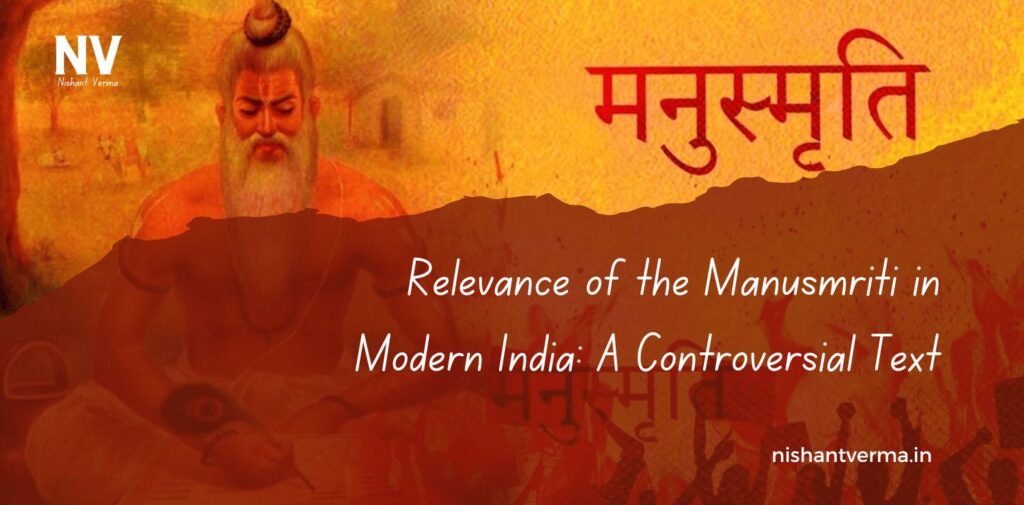The Manusmriti is an ancient Indian text that has been the subject of intense debate for centuries. It is often regarded as one of the earliest texts outlining social and moral conduct in Hindu society. But in today’s India, where the focus is on equality, social justice, and human rights, the Manusmriti raises several questions. Is this ancient text still relevant in modern India? Should it be followed or discarded entirely? Let’s explore the significance of theManusmriti in Modern India and its controversial place in contemporary society.
What is the Manusmriti?
The Manusmriti is a collection of ancient laws and codes attributed to the sage Manu. It is believed to have been written sometime between 200 BCE and 200 CE, though some scholars suggest it could be older. The text is a guide to righteous living, outlining the duties and responsibilities of individuals based on their caste, gender, and age. It is divided into several sections, each dealing with different aspects of life, including morality, ethics, and social conduct.
The Manusmriti is considered one of the first legal texts in India. It laid down a framework for the caste system and prescribed specific duties for each caste (Varna) and gender (particularly the role of women). Many of its ideas were influential in shaping Indian society for centuries. However, some of its teachings have been criticized for promoting inequality, especially towards women and lower castes.

Why is the Manusmriti Controversial?
Over time, the Manusmriti has been criticized for its rigid and discriminatory social hierarchy. Some of the most controversial aspects of the text include:
- Caste System: The Manusmriti is often blamed for reinforcing the caste system, which divides society into rigid groups and assigns individuals specific roles based on their birth. The text not only describes the duties of each caste but also dehumanizes those in lower castes (especially the “untouchables”) by assigning them degrading tasks.
- Gender Inequality: The Manusmriti also promotes a patriarchal view of women, prescribing subservience to their fathers, husbands, and sons. Women are often described as dependent and subordinate to men. For instance, it states that a woman’s “father is her protector before marriage, her husband is her protector during marriage, and her sons are her protectors in old age.”
- Punishments and Justice: The Manusmriti prescribes harsh punishments for those who break its rules. The punishment for many offenses, especially for those of lower castes, was often cruel and disproportionately severe. These extreme forms of justice were criticized for violating basic human rights.
Because of these aspects, many activists, scholars, and reformers have argued that the Manusmriti fosters inequality, discrimination, and injustice. Dr. B.R. Ambedkar, a prominent social reformer and the chief architect of the Indian Constitution, was one of the most vocal critics of the text. He famously called for the Manusmriti to be burned in protest of its discriminatory practices.

Has the Manusmriti Lost its Relevance in Modern India?
In modern India, the Constitution guarantees equality, freedom, and justice for all citizens, regardless of caste, gender, or religion. Given this, many people argue that the Manusmriti is outdated and irrelevant in today’s world. Here’s why some people believe the Manusmriti no longer holds any significance:
- Equality and Social Justice: The Indian Constitution, adopted in 1950, ensures the equality of all citizens. The ideals of social justice, human rights, and the eradication of untouchability directly conflict with many principles of the Manusmriti. The idea of “untouchability,” which is explicitly supported in the Manusmriti, was abolished through the Constitution, making its teachings incompatible with modern democratic values.
- Women’s Rights: India has made significant strides in promoting women’s rights over the years. The Manusmriti’s view of women as subservient beings, with no autonomy or independence, stands in direct contrast to the modern-day fight for women’s empowerment, gender equality, and women’s participation in all fields of life.
- Abolition of the Caste System: While the caste system still exists in some parts of India, modern India has made significant efforts to promote a more inclusive society. The Manusmriti’s reinforcement of caste-based discrimination is no longer in line with India’s commitment to creating a society free from caste-based distinctions and untouchability.
- Human Rights and Global Influence: Today’s India is a part of the global community, and it is expected to align with universal human rights principles. The Manusmriti’s harsh and discriminatory views contradict these international standards.
Is There Any Value in the Manusmriti Today?
Despite its controversial nature, some people believe that the Manusmriti can still provide valuable insights into Indian culture, history, and thought. Here’s why some argue that the text should not be entirely discarded:
- Cultural and Historical Understanding: The Manusmriti is an important historical text that offers insights into ancient Indian society, its values, and its legal system. It helps modern readers understand the evolution of Hindu thought, the development of social structures, and the influence of religious texts on Indian culture.
- Philosophical Lessons: Some of the moral lessons in the Manusmriti, such as the importance of truthfulness, non-violence, and respect for elders, continue to resonate with people today. While the text may have promoted rigid social categories, some of its core ideas about ethics and morality can still be seen as valuable in fostering personal responsibility and social harmony.
- The Debate on Reform: Many believe that ancient texts, including the Manusmriti, should not be dismissed outright but examined in a critical light. By understanding its flaws, we can learn how society has evolved and why reforms were necessary. This process of reinterpretation could lead to a more inclusive understanding of ancient texts, one that preserves their positive aspects while rejecting their discriminatory elements.

Can the Manusmriti Be Reformed?
The question of whether the Manusmriti can be reformed is a complex one. While it is unlikely that the text itself will change, modern interpretations of the text can evolve. Scholars and reformers can continue to engage with the Manusmriti in ways that challenge its outdated views while preserving its cultural and philosophical significance.
It is important to understand that the Manusmriti was written in a very different time, under different social conditions. Therefore, while some ideas in the text may be unacceptable today, others may still offer valuable insights into the ethical and moral framework of ancient Indian society. Rather than accepting or rejecting the Manusmriti wholesale, a nuanced and critical approach is needed to separate what is relevant from what is not.
Conclusion: Manusmriti in Modern India
The Manusmriti is undoubtedly a controversial and divisive text in modern India. Its promotion of caste-based discrimination and gender inequality makes it highly problematic in today’s world, especially in a country committed to equality and justice for all its citizens. However, the Manusmriti also offers a glimpse into the cultural and philosophical thinking of ancient India and can provide valuable lessons when studied critically.
Ultimately, the question of whether the Manusmriti should be “forgotten” or reformed is up to each individual and society at large. It’s essential to engage with the text, understand its historical context, and separate its negative aspects from its positive moral teachings. In the end, the Manusmriti should be seen not as a definitive guide to modern life, but as a product of its time—one that offers both lessons to learn from and injustices to reject.




